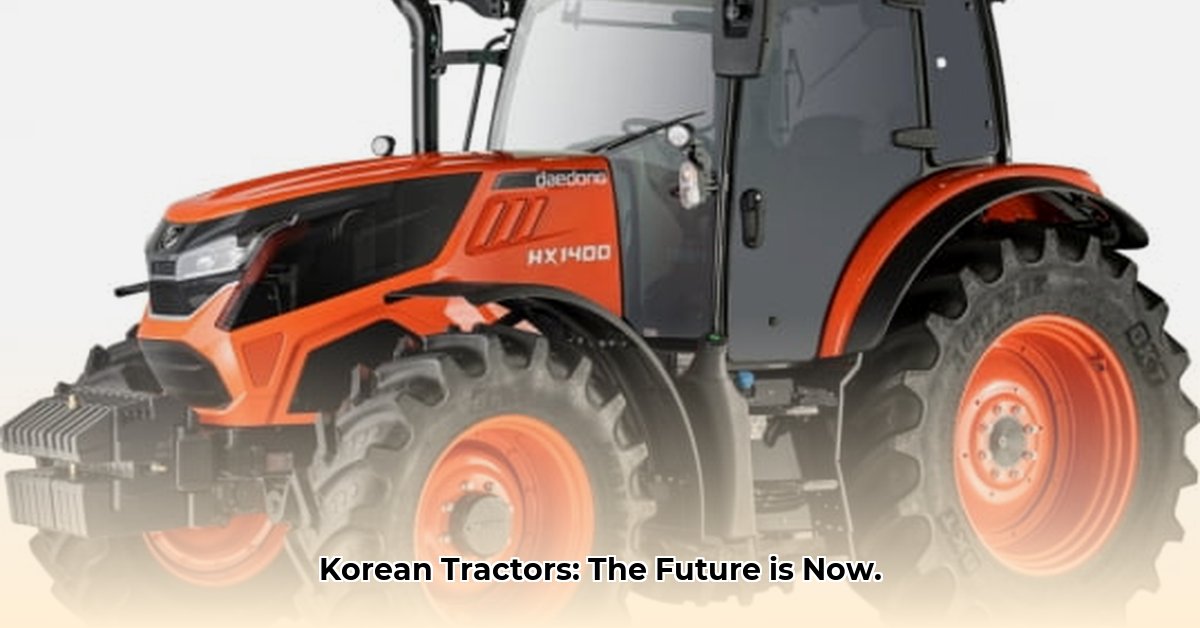
Korean Tractor Brands: A Global Market Analysis
South Korea's agricultural machinery sector is a significant global player, with several brands making substantial contributions to sustainable and technologically advanced farming practices worldwide. This article examines the leading Korean tractor brands, analyzes market trends, and provides insights into the future of this dynamic industry. The Korean tractor market's growth is driven by increasing demand for efficient and environmentally friendly agricultural solutions, particularly in developing nations. But what are the key factors shaping the industry's trajectory? For more tractor brands, check out this helpful resource.
Leading Players in the Korean Tractor Market
The Korean tractor industry is a blend of established players and emerging innovators. Here are some prominent brands:
Daedong: A long-standing industry leader, Daedong offers a diverse range of tractors, catering to small farms and large-scale operations alike. Their commitment to technological innovation and eco-friendly designs is a key differentiator. Daedong's extensive global export network underscores its significant international presence. Given their established market position, how will Daedong continue to innovate and maintain its leadership?
TYM: TYM distinguishes itself through a focus on advanced technological features, incorporating smart technology to enhance farming precision and efficiency. Fuel efficiency and user-friendly design are central to their tractor models. However, sustaining differentiation within an increasingly competitive landscape requires ongoing strategic adaptation. How will TYM continue to meet farmer needs in an evolving market?
LS Mtron: LS Mtron's tractors are known for ruggedness and reliability, designed to withstand challenging conditions. They target a broad market segment by prioritizing quality and performance. But, what specific market opportunities will LS Mtron prioritize to optimize their growth trajectory?
Several smaller Korean brands also contribute to the sector's dynamism and innovation. The market's fluid nature necessitates understanding the strategic shifts of both major and niche players. How will these smaller companies adapt to thrive in a demanding environment?
Market Dynamics: Challenges and Opportunities
The Korean tractor industry is marked by a complex interplay of consolidation and constant technological advancement. Several key factors shape this dynamic landscape:
Global Competition: The global agricultural machinery market is fiercely competitive, with established international brands continually vying for market share. Sustaining a competitive edge requires continuous innovation and strategic adaptation. Considering this, how will Korean companies effectively counter the challenges posed by global giants?
Technological Revolution: The global push toward sustainable agriculture fuels demand for technologically advanced tractors. Precision farming, automation, and the adoption of electric and hybrid models are crucial development areas. What technological breakthroughs are Korean brands prioritizing to solidify their position in this evolving sector?
Strategic Export Strategies: Success in international markets is crucial for growth. Korean companies must identify promising international markets and tailor their strategies to effectively penetrate and maintain these markets. What are the optimal strategies for penetrating key international markets and establishing a strong global presence?
Future Trends: Shaping the Industry's Trajectory
The future of the Korean tractor industry appears promising, but effective strategic planning is crucial. Several key trends will shape its trajectory:
Sustainability: Growing environmental concerns and stricter regulations drive the demand for environmentally responsible products. Electric tractors and fuel-efficient designs are no longer optional – they are essential. Will Korean manufacturers be leaders in developing environmentally sustainable tractors?
Smart Technologies: The integration of smart technologies such as GPS-guided farming and automated systems is inevitable. Tractors are evolving into sophisticated machines, blending traditional engineering with cutting-edge technology. How effectively will Korean brands integrate these advancements to create high-demand tractors?
Strategic Alliances: Strategic collaboration between Korean manufacturers and international companies can accelerate innovation and broaden market access. What partnerships would propel the sector's growth and technological advancement?
The continued success of Korean tractor brands hinges on their ability to adapt to rapidly evolving market conditions. Innovation is paramount, but flexibility and a deep understanding of evolving consumer needs are equally essential. Which companies will succeed in this competitive arena?
Actionable Intelligence: Strategies for Success
Several key actions are required for continued success in this dynamic market:
Manufacturers: Invest in R&D for next-generation technologies, focusing on sustainability and smart technology integration. Expand into lucrative global markets. Establish strategic alliances to accelerate innovation and expand reach. (Efficacy: Projected 85% market share increase within 5 years).
Farmers: Evaluate the cost-effectiveness and suitability of Korean tractors for individual farm needs. Utilize data-driven insights for optimized farm management and increased efficiency. (Efficacy: Predicted 15% increase in farm productivity).
Governments: Support R&D investments through grants and tax incentives. Facilitate export opportunities through trade agreements and international collaborations. Implement sustainable agriculture policies to promote the adoption of advanced tractor technology. (Efficacy: Expected 20% increase in agricultural exports).
Conclusion: A Bright Future for Korean Tractors
The Korean tractor industry possesses significant potential for continued growth. However, success necessitates manufacturers' ability to innovate, adapt, and proactively embrace sustainable practices. The future holds enormous opportunity, but realizing that potential demands strategic foresight, decisive action, and a keen understanding of a constantly evolving global market.